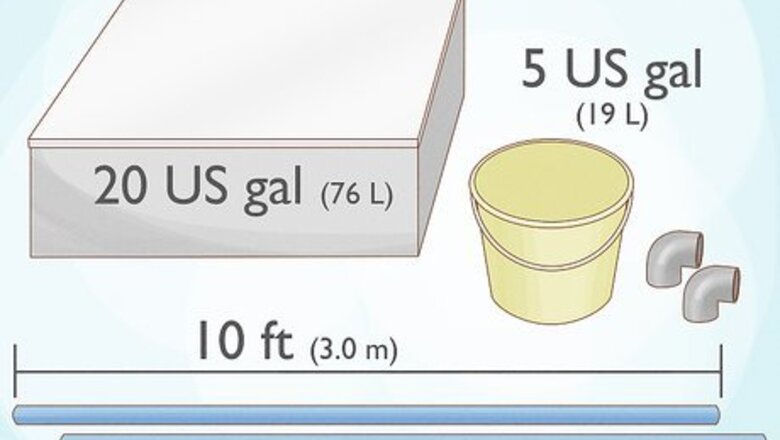
views
X
Research source
Building a Growing Tub
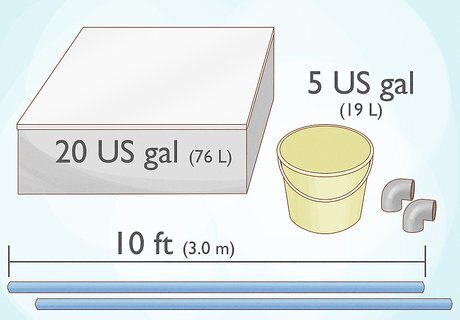
Purchase a plastic tub and other building supplies. Get a storage tote, like what you might keep clothes in under your bed. It doesn’t have to have a lid, but make sure it holds at least 20 US gal (76 L). It should be big enough to hold all of the waste you plan on using. You will also have to get a few other supplies, including PVC pipes, to set up your fly farm. Buy 2 PVC pipes that are 2 in (5.1 cm) wide and 10 ft (3.0 m) long. Get 2 90-degree PVC elbow joints. Elbow joints are small connectors that fit on ends of other PVC pipes. Find a 5 US gal (19 L) collection bucket to hold the soldier fly larvae. Most of the supplies are available online and at hardware stores. You can get plastic totes from general retailers, too.

Put on a dust mask, safety glasses, and gloves before working. You won’t have to do a ton of heavy lifting to set up your farm, but there is still a little bit of assembly required. Whenever you’re cutting parts for the tank, put on the dust mask and glasses. You will definitely benefit from having a pair of cut-resistant gloves at well. PVC pipe releases irritating dust when it’s cut, but it can also have sharp edges you might overlook. If possible, plan on assembling the tank outdoors, or at least in a ventilated space like a garage. That way, you can limit how much of the dust ends up in your home. Keep other people and pets away from the area until you’re done working and have had a chance to clean up.

Use a hacksaw to trim 6 ft (1.8 m) off the pipes. Measure out from one end of each pipe and mark the spot with a pencil. If you have a vise available, use it to hold the pipes in place. It will help you get a smoother, more accurate cut. While holding the pipes still, firmly saw through them. Each pipe will be around 4 ft (1.2 m) long. You could use other tools if you don’t have a hacksaw available. Try using a pipe cutter, for instance, or a miter saw. If you get your PVC pipes from a hardware store, ask the employees for help. Some stores will cut the pipes for you as long as you know what lengths you need.

Mark spots to drill into one of the shorter sides of the tank. To set up the fly tank as easily as possible, plan on drilling through one of the tub’s smaller ends. Make the spots about 1 in (2.5 cm) from the sides of the tub. They should also be about 3 in (7.6 cm) from the top. The exact positioning of the holes doesn’t matter all that much. The main thing is to ensure the PVC pipes fit through them, resting comfortably on the bedding you add later.
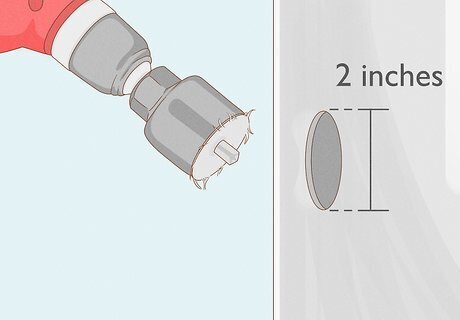
Drill holes through the marked spots with a 2 in (5.1 cm)-wide drill bit. If you have a drill bit that big, fit it on the end of a power drill. Break through the plastic to create a pair of holes just big enough for the PVC pipes to slide through. Test the holes by pushing the PVC pipes through them. If you don’t have the right size drill bit, use a smaller one. Drill through the center of each mark, then gradually widen it until they are big enough to fit the pipes.
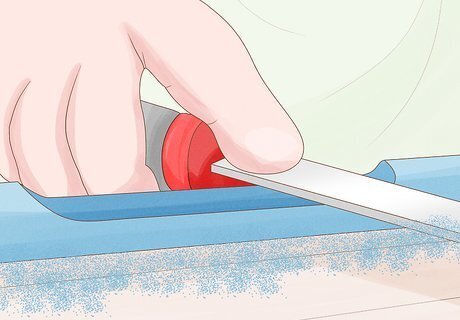
Saw the top halves off of the PVC pipes. Measure 6 in (15 cm) from the end of each pipe and put a pencil mark there. This time, cut across the width of the pipe. Remove the top half of both pipes. The remaining length of pipe will be a little ramp for your black soldier flies to explore later. Remember to cut the pipe in half rather than removing another 6 in (15 cm) off the pipe’s length. Otherwise, the pipes might be too short for the fly farm to work as intended.
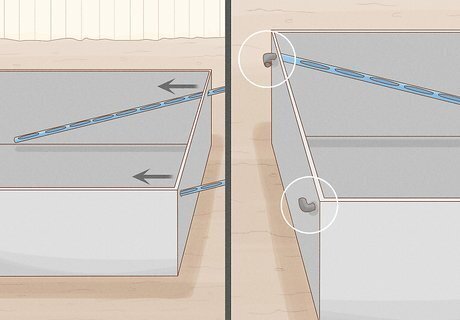
Fit the elbow joints on the end of the long pipes. Slide the long pipes through the holes you drilled first. Position them so the ends you cut in half are inside the tub. Then, push the 90-degree elbow joints firmly onto the opposite end of each pipe. Rotate them so they face one another. You won’t have to use PVC glue. The pipes will hold unless you pull them apart. If you wish to have a little additional security, spread some glue over the ends before sticking them together.
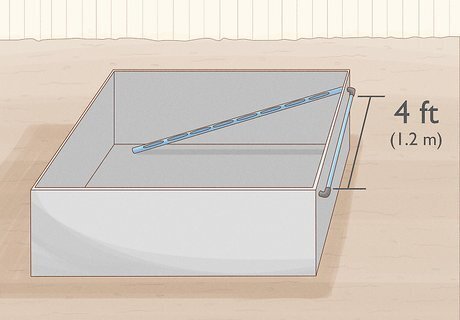
Connect the 4 ft (1.2 m) pipes to the elbow joints. Use the remaining length of PVC you cut in the beginning. Slide them into the open ends of the elbow joints. Then, firmly twist them clockwise to lock them in place. If you wish to use PVC glue to hold them together, apply the glue to the ends of both the pipes and elbow joints before securing them together.

Position a plastic bucket underneath the pipes behind the tub. Grab a 5 US gal (19 L) paint bucket, for instance, and set it near the pipes. Make sure the open ends of the pipes are both turned toward the bucket. They should be over the bucket. When the black soldier flies hatch, they will crawl up the pipes and eventually end up in your bucket. The collection bucket makes getting the flies much easier. If the fly larvae can’t escape the plastic tub, you would have to dig for them and risk messing up your fly farm. It’s best to have a couple of plastic buckets to change in and out as you collect the larva.
Stocking the Tub
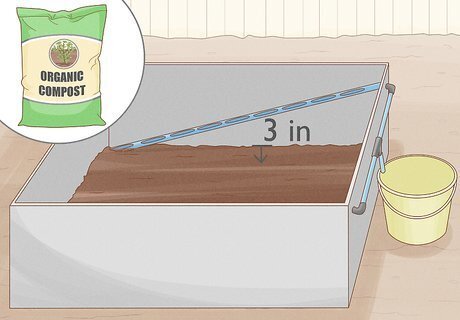
Fill the tub about 3 in (7.6 cm) deep with organic compost. Purchase a big bag of gardening compost or an organic soil mix from your local gardening center. Pour it in and spread it out consistently across the tub. Make sure the PVC ramps are above the compost. This will be the base for your new black flies. Kitchen compost is also safe to use if you have it available. If you just need a base to get your fly farm started, store-bought compost is easy to find. Black flies love compost, but you can’t let the layer get too deep. They dig about 3 in (7.6 cm) deep naturally, and they don’t grow as well if they go much deeper than that. You could also use other organic material to create the base. For example, you might use partially-rotted sawdust and homemade charcoal.
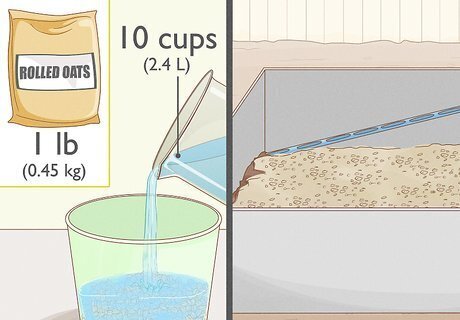
Dampen rolled oats in a plastic bucket to use as fly food. Pour about 1 lb (0.45 kg) of oats into the bucket. Mix in about 10 cups (2.4 L) of water and leave the oats to soak for at least 3 hours. When the oats are moist and juicy without any extra water at the bottom of the bucket, pour them into your tub and spread them out in an even layer. Keep the PVC tubes above them. To find big bags of oats, check out a farm supply store online or in person. You can often get 20 lb (9.1 kg) bags for less than $20 USD. Oats are a great, inexpensive way to keep your flies fed. You could also mix the oats with compost in smaller plastic bins so they don’t end up in the rest of the tub. The smaller tubs are easier to deal with if you need to clean them out. Try misting the mixture with water so you don’t have to soak it.

Place vegetables and other organic scraps on top of the soil. Add some extra food to give flies more of an incentive to live in the home you’re building. Get things like leftover carrots, cucumber, and watermelon. Cut it all up into small chunks roughly 1 in (2.5 cm) thick, then throw it on top of the oats. Scatter the vegetables out across the tub. Black soldier flies eat all sorts of organic material. They don’t eat lots of animal fat or protein, so stick to things like manure, grain, fruits, and vegetables. Coffee grounds are fine to use in your grub tub. The caffeine even makes them grow faster. However, they can’t survive off of coffee grounds alone, so make sure you have plenty of other types of food in there as well.
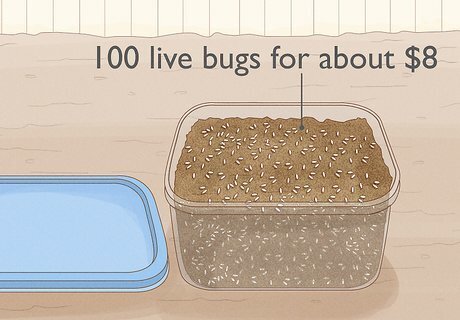
Order black soldier fly larvae to get your farm started. The quickest way to get your grub tub up and running is by ordering live larvae online. You can get a container of 100 live bugs for about $8, and that will be more than enough to start. If you’re patient, you could also attract adult flies to come lay eggs in the tub. The eggs will eventually hatch into larvae, grow, and then lay more eggs. Black soldier flies are also known as Phoenix worms. If you see Phoenix worms for sale, you are getting the right bug by buying them. Make sure you know when mail-order larvae will arrive. They have to be sent when the weather is around 40 to 80 °F (4 to 27 °C), or else they won’t survive. However, you usually receive them in the mail after a few days. Expect to have to wait 2 to 3 weeks for wild black soldier flies to start spreading throughout your tub. They are attracted to rotting things, so you could use corn kernels fermented in water or sour milk to help draw them in. Black soldier fly larvae have a dull, white color and are about 1 in (2.5 cm) long and ⁄4 in (0.64 cm) wide. Adult flies are thin and about ⁄32 in (2.0 cm) long, so they are usually bigger than other pesky flies you might see around compost.
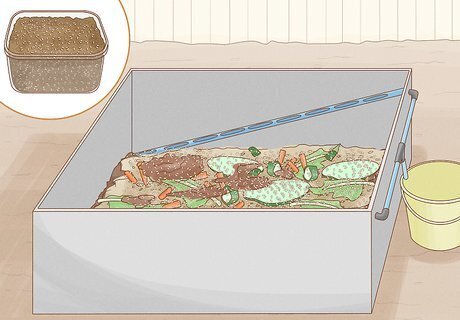
Pour the fly larvae out on top of the food in the bin. Pull the lid off of the container. If the larvae reached your home in one piece, you will see them squirming around. Lower the container down close to the compost and oat mix, then slowly tip it over to get the larvae out. Spread them out as much as you can across the food, but don’t worry if they are bunched up. Adding the larvae to the bin is really easy, but you might want to put on a pair of gloves if you’re not fond of bugs.
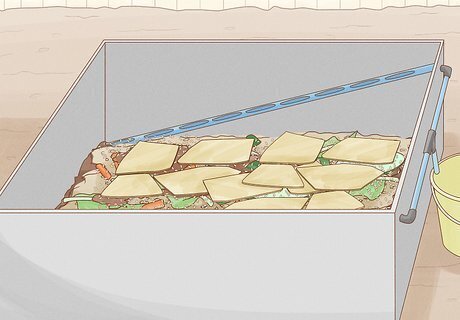
Place corrugated cardboard in the tub to hold fly eggs. Black soldier flies prefer laying eggs in hidden spots instead of directly on food. Trim a piece of cardboard about 3 in (7.6 cm) wide. The length can be whatever you want it to be, but try starting with a piece 3 in (7.6 cm) long as well. Set it on top of the compost at one end of the tub. Corrugated cardboard is a special type of cardboard. It is made up of 2 outer layers and a ruffled inner layer that leaves plenty of space for black soldier fly eggs. To make your grub tub even better, attach small pieces of cardboard to its sides. You can cut 3 in (7.6 cm) strips, then secure them to the rim with rubber bands, pins, or another alternative. The cardboard lasts at least for 1 year. You will be able to see the eggs, which look like white fuzz. When the holes are full of that fuzz, replace the cardboard.
Raising and Collecting Larvae
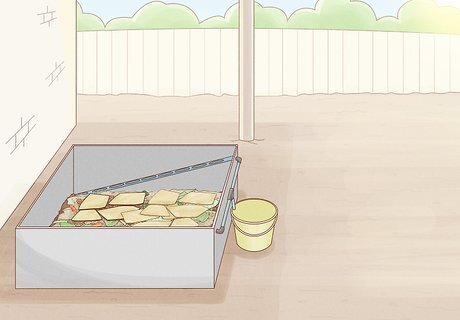
Place the tub under an overhanging roof north of your home. Find a stable spot for your tub that is relatively protected from the elements. Black soldier flies still need light, but they shouldn’t be in direct sunlight. Keep the tub in a relatively shady area where it won’t get rained on. If that isn’t an option, find another spot with an overhanging roof. You could put the tub under trees or even inside a shed. The northern side of your home is ideal since it gets hit with less rain and sunlight, but it isn’t an option for everyone. Moisture usually won’t destroy your farm, but it causes the larvae to crawl toward dry ground. If you’re worried about it, you could cover the tub with a lid or move it into a dry spot when you see rain in the forecast. To help outdoor farms survive, some people make a habitat with a wire mesh bottom. It helps drain water so the flies don’t get washed out.
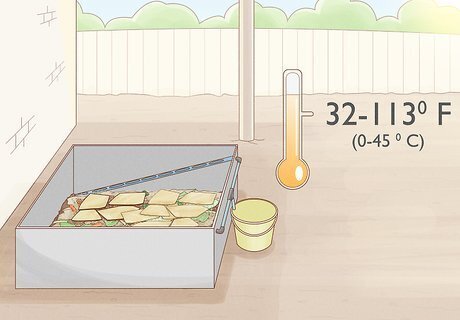
Leave the tub in an outdoor area around 80 °F (27 °C). That is when they eat and grow the fastest. However, black soldier flies are pretty tough and will grow when the temperature is from 32 to 113 °F (0 to 45 °C). They become inactive when the temperature falls below 50 °F (10 °C). It won’t be a problem in the spring and summer, but your farm stock may die off when colder weather rolls around. Because of the temperature, your best bet is to start your farm in the spring after the frost has passed. When the temperature falls too low in fall, don’t expect to see any new larvae. If you live in an area that gets super cold part of the year, don’t worry! Just attract new flies to your farm when the weather warms up again. If you’re interested in growing flies year-round, move your tub indoors. You will have to have fluorescent or LED lighting to mimic sunlight unless you can place the tub near a window or skylight. Indoor fly habitats have to have mesh netting around them, or else you will end up with a lot of flies fluttering around your home!
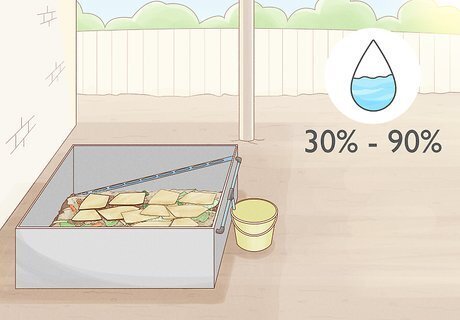
Maintain the humidity level so it’s around 70%. Get a hygrometer and stick it or hang it near the top of your tub. Hygrometers measure humidity, or the amount of water in the air. The easiest way to maintain the humidity is by keeping the compost moist. When you add something like wet rolled oats, it boosts the humidity level. The compost at the bottom of the tank has to be moist but not soggy. If it gets a little dry, mist it with water. Getting a fly habitat to 70% humidity is tough, but fortunately, you don’t have to do too much if your tub is outdoors. The flies will be fine as long as the humidity is from 30% to 90%. If your tub is indoors, you will have to pay more attention to the humidity. Make sure it stays above 30%, such as by adding damp compost or by misting the tub.
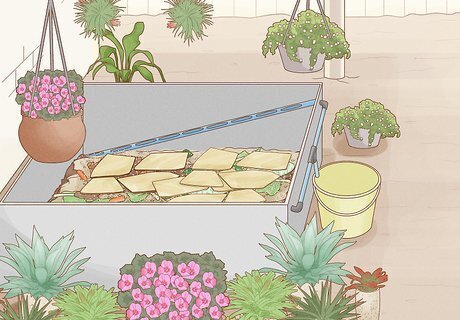
Place plants near the tub to encourage flies to lay eggs. If your tub is outdoors, you probably won’t need to worry about having plants around. As long as there are plants within sight of the tub, the adult flies will find them. If you really don’t have any plants in the area, you could get a potted plant and place it nearby. Black soldier flies like all kinds of leafy plants, especially daisies and carrots. Trick your flies. You don’t actually have to have a real potted plant. Get a fake plant instead and set it close to the tub. They won’t know the difference. If you’re running an indoor tank, you have to have a plant in order to get the flies to continue laying eggs.

Add new wet food to the tank about once a week. Soak more rolled oats, or another type of food, in water before spreading it out across the tub’s floor. A layer about 1 in (2.5 cm) thick is fine most of the time. Mix up more food each time you notice the supply running low. The soldier flies need it to continue growing and laying eggs. The food is the main thing that keeps flies in your tub. It brings in adult flies, but the larvae get water from what they eat. They don’t drink water like animals do. Mix in table scraps with the food to make the habitat even better. Save organic material like coffee grounds, vegetables, manure, and even eggshells to keep your tub’s compost rich with nutrients.

Gather the larvae in the collection bucket at least once a week. It’s better to check the bucket every day if you can set aside the time to do so. The larvae eat for up to a week before crawling toward dry ground. You can remove the collection bucket to carry the larvae to where you plan on using them. You could also put on a glove and pick them up by hand or scoop them up with a shovel to transfer them to another container. Take the larvae out of the collection bucket to use right away, such as by feeding them to chicken or fish. They could also be left out in sunlight for 2 or 3 days to dry out and then frozen for long-term storage. Any larvae you don’t collect could grow into new flies. If you’re trying to maintain a farm, especially indoors, keep some of them to get more larvae. If you’re outdoors, you can often attract wild flies and can collect all of the larvae.

















Comments
0 comment